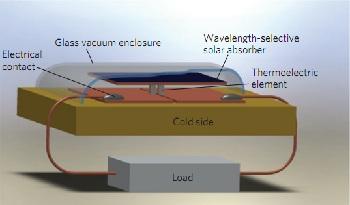Using AI to control energy for indoor agriculture
30 September 2024
Published online 5 May 2011

There are two main methods for harvesting solar energy to produce electricity: photovoltaic cells, which use semiconductors to convert solar radiation directly into electricity; and solar thermal power generation, which uses mirrors or lenses to concentrate solar heat to produce electricity in large-scale power plants using steam turbines.
Generation of solar thermoelectricity is dependent on creating a significant temperature difference across the thermoelectric device. Low solar radiation falling on a flat panel would create a temperature difference of only 1–5 ºC — far too small to produce electricity. That is why large lenses and mirrors are used to concentrate solar radiation on the generator, to increase the heat flux up to 600 ºC. However, these require complex and expensive systems to track the position of the Sun in order to stay efficient, thus adding extra costs to the devices.
Researchers from universities in the United States and the Masdar Institute of Science and Technology in Abu Dhabi, United Arab Emirates, were able to produce flat-panel solar thermoelectric generators that have an efficiency of 4.6–5.2%, which is around seven times higher than the best results produced in the past by similar panels, and that do not need the complex tracking systems.
"I think the most exciting aspect is that our device can be potentially low cost, enabled by the design we invented, together with advances in materials," said Gang Chen, a mechanical engineer at the Massachusetts Institute of Technology (MIT) and one of the authors of the paper.
The experimental devices are made of a nanostructured thermoelectric material, which offers high performance, and are covered by wavelength-selective solar absorbers that yield better results than the black absorbers used in other devices. They are also enclosed in a vacuum, which reduces the heat that was previously lost to air and makes it possible to concentrate solar energy to the thermoelectric generators through conduction along the absorber, rather than optically concentrating light.
The researchers contend that, with further research and development, their experiment could make solar thermoelectricity generation a key method in supplying renewable energy.
doi:10.1038/nmiddleeast.2011.54
Stay connected: